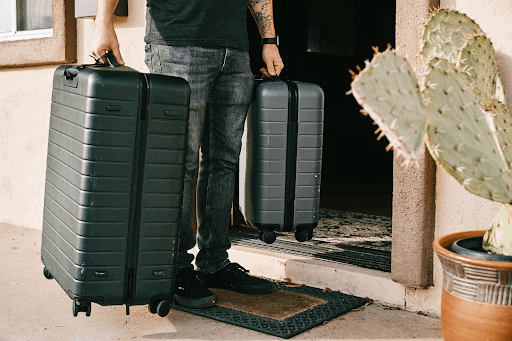Safe Travels: How To Secure Your Luggage
June 13, 2022

Now that travel is ramping up again, you may be planning a trip sometime in 2022. If you are, you’ll want to make sure you know everything about keeping your luggage safe. The fear of losing luggage can be daunting, but we’ve provided some tips to help you along the way. With the following suggestions, you’ll be able to keep valuable items safe and make sure your luggage makes it to your destination in one piece.
Pack Lightly
Less is more, especially when weighing the risk of losing items. Avoid bringing highly valuable or sentimental items. Take staple clothing items that you can wear interchangeably. For most travel purposes, you’ll only need a couple of pairs of shoes. You can find travel sizes of your necessities or get TSA-sized containers to put them in. You’ll also want to learn some suitcase organization tips. If you throw everything into the suitcase without care, you won’t have any idea if your luggage has been tampered with! Add only what you need, and do so in an organized fashion.
Get Creative With Valuables
If you decide to bring any valuables with you, get creative with how you store them. You can hide jewelry in socks, or mix it in with your toiletries. If you need to bring cash with you, tuck it into a book where it will be well concealed. Some have even opted to use empty deodorant containers as vessels for valuables. However, the most reliable place to keep valuables when traveling is in your carry-on. This way, you can keep an eye on them at all times.
Follow TSA Guidelines
If you’ve traveled before, you’ve surely visited the TSA website to check which items are permitted. You may store liquids in bottles that are 3.4 oz or smaller inside a sealed quart-sized bag within your carry-on. Larger liquid containers can go inside your checked baggage, but it’s recommended to pack lighter with travel-sized containers.
TSA also defines which locks to use when securing your luggage. TSA-approved locks can be opened with a universal master key. If you don’t comply with these guidelines, they’ll have to cut your lock open. When using the correct lock, the only people getting into your luggage are you and the TSA employees.
Make Your Luggage Stand Out
If your luggage looks like every other suitcase at baggage claim, you run a much greater risk of losing it. The last thing you want is someone else walking off with your luggage because it’s identical to theirs. To help your luggage stand out, you can tie a colored ribbon around the handle or add stickers from your favorite vacations. In addition, you should always have luggage tags filled out on each bag or suitcase you use to travel. If your suitcase or bag does get misplaced, having a luggage tag is the most efficient way for someone to get it back to you.
Be Aware of Your Surroundings
Common sense tells us we should keep our luggage in sight at all times. The reality of this is, it’s easier said than done. If you travel with a carry-on, have it in your hands or your lap while you wait for the plane. If you take the tram to get across the airport, stay aware of what’s happening around you. Avoid looking down on your phone. Be careful in crowded spaces and hold tight to your items when you bump into people. This is an easy way for thieves to grab your bags without you noticing.
Track Your Luggage
As crazy as it may sound, you can buy a tracker to place in your suitcase and track it with your phone. It’s like you’re a secret agent all of a sudden! Be sure to read reviews on trackers, as some may work better than others. If your luggage ends up lost or stolen, a suitcase tracker will save you a lot of time and stress. Plus, you get to have a little fun in the process.
Purchase Travel Insurance
When in doubt, travel insurance is always a great option. Not only will travel insurance protect you from any health issues or injuries while you’re out of town, but it’ll also reimburse you for missing luggage, unlike most airlines. However, as with all insurance policies and documents, be sure to read the fine print. Every insurance company varies in its maximum coverage amount. If you’re traveling with valuables, you’ll want to be sure the insurance will cover those as well. Some travel insurance policies also result in a deductible when your luggage is misplaced. In most cases, it’s still worth it to purchase insurance.
Traveling can be stressful, but that shouldn’t take away from the fun. Packing lightly, tagging your luggage, and investing in travel insurance are only a few of the ways to keep your luggage secure. Brothers Locksmith is here to help you worry less and explore more in 2022 with these simple tips.
Call Us Any Time!
Wondering if you should change your locks after a cleaner or repairman visits? Learn when rekeying is necessary, security risks to watch for, and expert guidance from Brothers Locksmith.
Worried your home may be targeted for a break-in? Learn the top warning signs burglars look for, how to spot suspicious activity early, and smart ways to secure your property. Get expert tips from professional locksmiths to stay protected before trouble happens.







